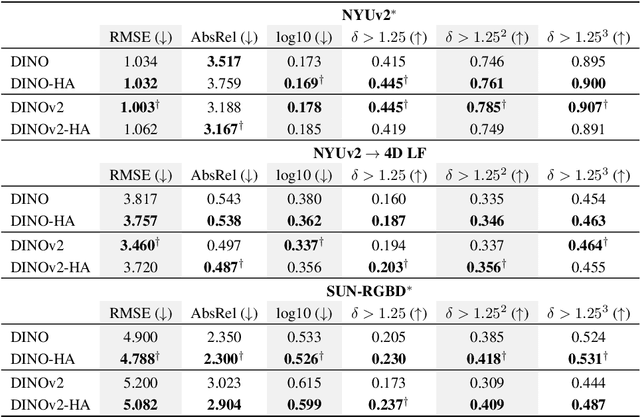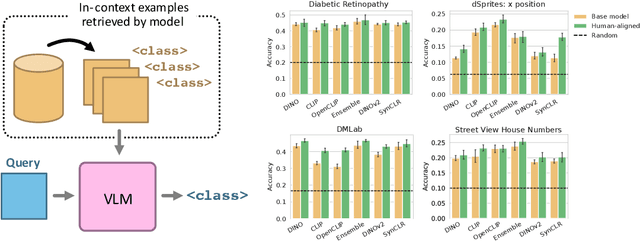Simon Kornblith
Training objective drives the consistency of representational similarity across datasets
Nov 08, 2024



Abstract:The Platonic Representation Hypothesis claims that recent foundation models are converging to a shared representation space as a function of their downstream task performance, irrespective of the objectives and data modalities used to train these models. Representational similarity is generally measured for individual datasets and is not necessarily consistent across datasets. Thus, one may wonder whether this convergence of model representations is confounded by the datasets commonly used in machine learning. Here, we propose a systematic way to measure how representational similarity between models varies with the set of stimuli used to construct the representations. We find that the objective function is the most crucial factor in determining the consistency of representational similarities across datasets. Specifically, self-supervised vision models learn representations whose relative pairwise similarities generalize better from one dataset to another compared to those of image classification or image-text models. Moreover, the correspondence between representational similarities and the models' task behavior is dataset-dependent, being most strongly pronounced for single-domain datasets. Our work provides a framework for systematically measuring similarities of model representations across datasets and linking those similarities to differences in task behavior.
When Does Perceptual Alignment Benefit Vision Representations?
Oct 14, 2024



Abstract:Humans judge perceptual similarity according to diverse visual attributes, including scene layout, subject location, and camera pose. Existing vision models understand a wide range of semantic abstractions but improperly weigh these attributes and thus make inferences misaligned with human perception. While vision representations have previously benefited from alignment in contexts like image generation, the utility of perceptually aligned representations in more general-purpose settings remains unclear. Here, we investigate how aligning vision model representations to human perceptual judgments impacts their usability across diverse computer vision tasks. We finetune state-of-the-art models on human similarity judgments for image triplets and evaluate them across standard vision benchmarks. We find that aligning models to perceptual judgments yields representations that improve upon the original backbones across many downstream tasks, including counting, segmentation, depth estimation, instance retrieval, and retrieval-augmented generation. In addition, we find that performance is widely preserved on other tasks, including specialized out-of-distribution domains such as in medical imaging and 3D environment frames. Our results suggest that injecting an inductive bias about human perceptual knowledge into vision models can contribute to better representations.
Aligning Machine and Human Visual Representations across Abstraction Levels
Sep 10, 2024Abstract:Deep neural networks have achieved success across a wide range of applications, including as models of human behavior in vision tasks. However, neural network training and human learning differ in fundamental ways, and neural networks often fail to generalize as robustly as humans do, raising questions regarding the similarity of their underlying representations. What is missing for modern learning systems to exhibit more human-like behavior? We highlight a key misalignment between vision models and humans: whereas human conceptual knowledge is hierarchically organized from fine- to coarse-scale distinctions, model representations do not accurately capture all these levels of abstraction. To address this misalignment, we first train a teacher model to imitate human judgments, then transfer human-like structure from its representations into pretrained state-of-the-art vision foundation models. These human-aligned models more accurately approximate human behavior and uncertainty across a wide range of similarity tasks, including a new dataset of human judgments spanning multiple levels of semantic abstractions. They also perform better on a diverse set of machine learning tasks, increasing generalization and out-of-distribution robustness. Thus, infusing neural networks with additional human knowledge yields a best-of-both-worlds representation that is both more consistent with human cognition and more practically useful, thus paving the way toward more robust, interpretable, and human-like artificial intelligence systems.
Training Language Models on the Knowledge Graph: Insights on Hallucinations and Their Detectability
Aug 14, 2024



Abstract:While many capabilities of language models (LMs) improve with increased training budget, the influence of scale on hallucinations is not yet fully understood. Hallucinations come in many forms, and there is no universally accepted definition. We thus focus on studying only those hallucinations where a correct answer appears verbatim in the training set. To fully control the training data content, we construct a knowledge graph (KG)-based dataset, and use it to train a set of increasingly large LMs. We find that for a fixed dataset, larger and longer-trained LMs hallucinate less. However, hallucinating on $\leq5$% of the training data requires an order of magnitude larger model, and thus an order of magnitude more compute, than Hoffmann et al. (2022) reported was optimal. Given this costliness, we study how hallucination detectors depend on scale. While we see detector size improves performance on fixed LM's outputs, we find an inverse relationship between the scale of the LM and the detectability of its hallucinations.
Neither hype nor gloom do DNNs justice
Dec 08, 2023Abstract:Neither the hype exemplified in some exaggerated claims about deep neural networks (DNNs), nor the gloom expressed by Bowers et al. do DNNs as models in vision science justice: DNNs rapidly evolve, and today's limitations are often tomorrow's successes. In addition, providing explanations as well as prediction and image-computability are model desiderata; one should not be favoured at the expense of the other.
Frontier Language Models are not Robust to Adversarial Arithmetic, or "What do I need to say so you agree 2+2=5?
Nov 15, 2023



Abstract:We introduce and study the problem of adversarial arithmetic, which provides a simple yet challenging testbed for language model alignment. This problem is comprised of arithmetic questions posed in natural language, with an arbitrary adversarial string inserted before the question is complete. Even in the simple setting of 1-digit addition problems, it is easy to find adversarial prompts that make all tested models (including PaLM2, GPT4, Claude2) misbehave, and even to steer models to a particular wrong answer. We additionally provide a simple algorithm for finding successful attacks by querying those same models, which we name "prompt inversion rejection sampling" (PIRS). We finally show that models can be partially hardened against these attacks via reinforcement learning and via agentic constitutional loops. However, we were not able to make a language model fully robust against adversarial arithmetic attacks.
Probing clustering in neural network representations
Nov 14, 2023Abstract:Neural network representations contain structure beyond what was present in the training labels. For instance, representations of images that are visually or semantically similar tend to lie closer to each other than to dissimilar images, regardless of their labels. Clustering these representations can thus provide insights into dataset properties as well as the network internals. In this work, we study how the many design choices involved in neural network training affect the clusters formed in the hidden representations. To do so, we establish an evaluation setup based on the BREEDS hierarchy, for the task of subclass clustering after training models with only superclass information. We isolate the training dataset and architecture as important factors affecting clusterability. Datasets with labeled classes consisting of unrelated subclasses yield much better clusterability than those following a natural hierarchy. When using pretrained models to cluster representations on downstream datasets, models pretrained on subclass labels provide better clusterability than models pretrained on superclass labels, but only when there is a high degree of domain overlap between the pretraining and downstream data. Architecturally, we find that normalization strategies affect which layers yield the best clustering performance, and, surprisingly, Vision Transformers attain lower subclass clusterability than ResNets.
Getting aligned on representational alignment
Nov 02, 2023Abstract:Biological and artificial information processing systems form representations that they can use to categorize, reason, plan, navigate, and make decisions. How can we measure the extent to which the representations formed by these diverse systems agree? Do similarities in representations then translate into similar behavior? How can a system's representations be modified to better match those of another system? These questions pertaining to the study of representational alignment are at the heart of some of the most active research areas in cognitive science, neuroscience, and machine learning. For example, cognitive scientists measure the representational alignment of multiple individuals to identify shared cognitive priors, neuroscientists align fMRI responses from multiple individuals into a shared representational space for group-level analyses, and ML researchers distill knowledge from teacher models into student models by increasing their alignment. Unfortunately, there is limited knowledge transfer between research communities interested in representational alignment, so progress in one field often ends up being rediscovered independently in another. Thus, greater cross-field communication would be advantageous. To improve communication between these fields, we propose a unifying framework that can serve as a common language between researchers studying representational alignment. We survey the literature from all three fields and demonstrate how prior work fits into this framework. Finally, we lay out open problems in representational alignment where progress can benefit all three of these fields. We hope that our work can catalyze cross-disciplinary collaboration and accelerate progress for all communities studying and developing information processing systems. We note that this is a working paper and encourage readers to reach out with their suggestions for future revisions.
Small-scale proxies for large-scale Transformer training instabilities
Sep 25, 2023



Abstract:Teams that have trained large Transformer-based models have reported training instabilities at large scale that did not appear when training with the same hyperparameters at smaller scales. Although the causes of such instabilities are of scientific interest, the amount of resources required to reproduce them has made investigation difficult. In this work, we seek ways to reproduce and study training stability and instability at smaller scales. First, we focus on two sources of training instability described in previous work: the growth of logits in attention layers (Dehghani et al., 2023) and divergence of the output logits from the log probabilities (Chowdhery et al., 2022). By measuring the relationship between learning rate and loss across scales, we show that these instabilities also appear in small models when training at high learning rates, and that mitigations previously employed at large scales are equally effective in this regime. This prompts us to investigate the extent to which other known optimizer and model interventions influence the sensitivity of the final loss to changes in the learning rate. To this end, we study methods such as warm-up, weight decay, and the $\mu$Param (Yang et al., 2022), and combine techniques to train small models that achieve similar losses across orders of magnitude of learning rate variation. Finally, to conclude our exploration we study two cases where instabilities can be predicted before they emerge by examining the scaling behavior of model activation and gradient norms.
Replacing softmax with ReLU in Vision Transformers
Sep 15, 2023



Abstract:Previous research observed accuracy degradation when replacing the attention softmax with a point-wise activation such as ReLU. In the context of vision transformers, we find that this degradation is mitigated when dividing by sequence length. Our experiments training small to large vision transformers on ImageNet-21k indicate that ReLU-attention can approach or match the performance of softmax-attention in terms of scaling behavior as a function of compute.
 Add to Chrome
Add to Chrome Add to Firefox
Add to Firefox Add to Edge
Add to Edge